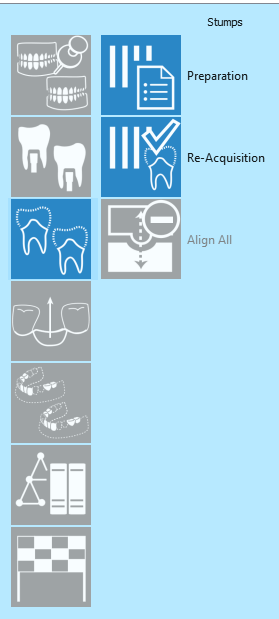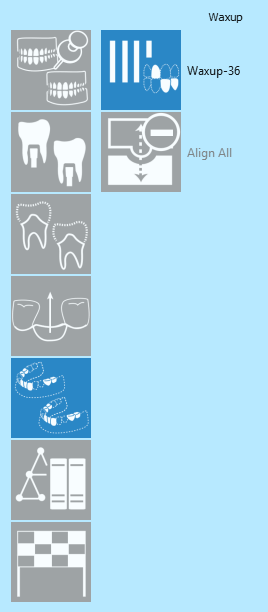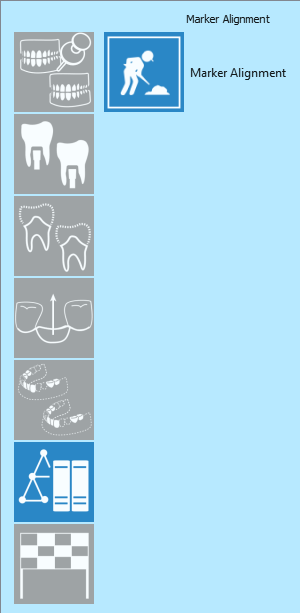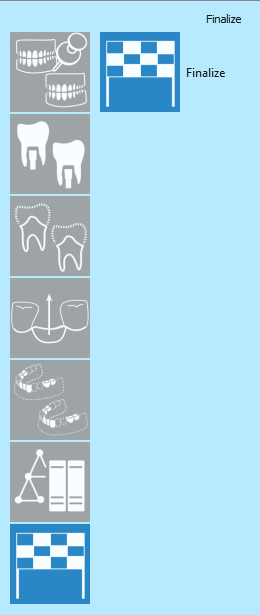Project items and Scan Groups
Contents
Estrutura
A estrutura do Assistente gera de acordo com a definição do projeto; portanto ele muda para se adaptar aos elementos que precisam ser escaneados para qualquer projeto específico.
Cada ícone da lista de etapas representa um grupo de escaneamento ou uma ação de projeto. Na imagem a seguir, encontramos todos os grupos de escaneamento e ações que podem aparecer em projetos padrão, embora seja improvável que todos eles sejam encontrados no mesmo projeto.
Grupos de Escaneamento
Aqui abaixo, encontre os grupos de escaneamento disponíveis em um projeto padrão e os outros possíveis grupos de escaneamento e itens disponíveis em projetos especiais (módulo concept quad / impressão etc.)
Arcadas
O primeiro grupo contém todos os elementos que funcionarão como referência para os outros escaneamentos. Ao clicar no ícone Template:Botão na linha, o grupo é aberto e as etapas individuais são mostradas.
 Articulator scan or scan of the occlusion: this scan can be performed either by scanning any kind of articulator on the articulator support plate or by scanning two models one on top of the other on the normal model holder.
Articulator scan or scan of the occlusion: this scan can be performed either by scanning any kind of articulator on the articulator support plate or by scanning two models one on top of the other on the normal model holder. Model Scan, upper or lower: if both models need to be scanned, the first one will always be the lower. For this scan, the models need to be inserted in the scanner without silicon gingivas, markers, preops or waxups.
Model Scan, upper or lower: if both models need to be scanned, the first one will always be the lower. For this scan, the models need to be inserted in the scanner without silicon gingivas, markers, preops or waxups. Waxup reference acquisition: The waxup reference needs to be scanned on top of the model to get the position reference.
Waxup reference acquisition: The waxup reference needs to be scanned on top of the model to get the position reference.
Implants
In this group ![]() are required all the marker elements that need to be scanned to acquire the position of the implants.
are required all the marker elements that need to be scanned to acquire the position of the implants.
 Marker acquisition: the markers need to be scanned on top of the analogues of the model to register the correct position of the implants. It is possible to scan multiple markers at the same time.
Marker acquisition: the markers need to be scanned on top of the analogues of the model to register the correct position of the implants. It is possible to scan multiple markers at the same time.
Dies
In this group ![]() it is asked to scan the dies present in the project.
it is asked to scan the dies present in the project.
 Multi die preparation: the user is required to accept the scan configuration for the dies or to create a new scan order.
Multi die preparation: the user is required to accept the scan configuration for the dies or to create a new scan order.- 40px Dies acquisition: the dies can be scanned either on the multi die or on the normal model holder.
Various
The group various, here represented with the icon ![]() , collects all the side elements of the projects, all those items that are not strictly necessary but that add valuable information at the project.
, collects all the side elements of the projects, all those items that are not strictly necessary but that add valuable information at the project.
 Healthy teeth: scan of the healthy, adjacent and pontic elements of one model. This scan is actually copied from the first acquired image of the model therefore it is seldom necessary for the user to scan these parts again.
Healthy teeth: scan of the healthy, adjacent and pontic elements of one model. This scan is actually copied from the first acquired image of the model therefore it is seldom necessary for the user to scan these parts again.- 40px Gingiva Scan: scan of the silicon gingiva on top of the model when present.
- 40px PreOp Scan: acquisition of a previous model of the patient, or previously designed anatomical part, that can be used as reference for designing the restoration.
Waxup
Group for the acquisition of the waxup ![]() , to be aligned with the reference scanned in the first group.
, to be aligned with the reference scanned in the first group.
 Waxup: detailed acquisition of teh waxup. In a secundary step it is also possible to scan the bottom part of the waxup; this step can be skipped.
Waxup: detailed acquisition of teh waxup. In a secundary step it is also possible to scan the bottom part of the waxup; this step can be skipped.
Others
Some scan groups and items are not present in the given list, because they appear only in certain conditions and with certain license modules.
Concept Quad Scan Group
The concept quad scan group ![]() is activated if, in project definition, the chosen model type is Quadrant
is activated if, in project definition, the chosen model type is Quadrant ![]() .
.
 Quadrant scan: scan of the elements of a quadrant tray articulator. The elements will be positioned all together on the concept quad model holder, and the scanner will acquire upper model, lower model and up to 4 dies in one single scan.
Quadrant scan: scan of the elements of a quadrant tray articulator. The elements will be positioned all together on the concept quad model holder, and the scanner will acquire upper model, lower model and up to 4 dies in one single scan.
Impression
The impression scan is activated if, in project definition, the chosen model type is Impression ![]() .
.
 Impression scan: scan of an impression tray. This procedure takes longer than any other due to the fact that, to scan negative items, more images are required.
Impression scan: scan of an impression tray. This procedure takes longer than any other due to the fact that, to scan negative items, more images are required.
Bite
The bite scan is activated if, in project definition, the antagonist is set to be a Silicon bite x25px.
Wizard Actions
Alignment
In almost every scan group is also present an align icon, to match the scanned items to their reference:
 Align icon: once the items have been acquired they get aligned to their reference. This option is not available until at least two items have been scanned.
Align icon: once the items have been acquired they get aligned to their reference. This option is not available until at least two items have been scanned.
Marker Alignment
In projects with implants, one of the wizard steps is the alignment of the scanned item to the implant library ![]() .
.
- 40px Marker alignment: alignment of the stl of the scanned marker/ scan body to its corresponding geometrical shape of the implant library.
Finalize
The Finalize list and button ![]() represent the last step of the project when the mesh generation is created and the file can be exported.
represent the last step of the project when the mesh generation is created and the file can be exported.









